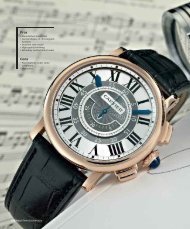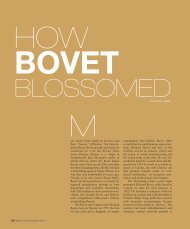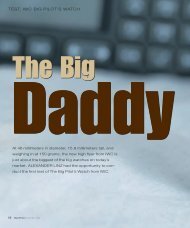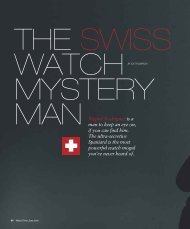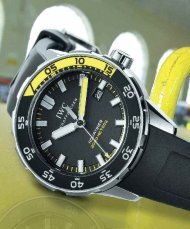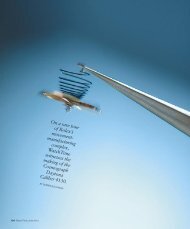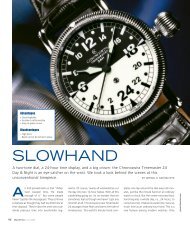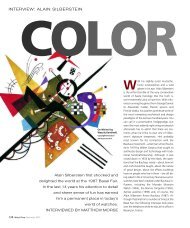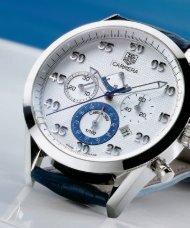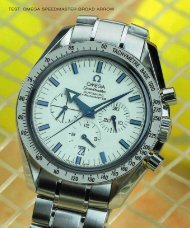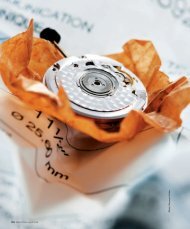WT_2010_01: TEST: TAG HEUER GRAND CARRERA CALIBRE 36 ...
WT_2010_01: TEST: TAG HEUER GRAND CARRERA CALIBRE 36 ...
WT_2010_01: TEST: TAG HEUER GRAND CARRERA CALIBRE 36 ...
Create successful ePaper yourself
Turn your PDF publications into a flip-book with our unique Google optimized e-Paper software.
BY ALEXANDER KRUPP<br />
PHOTOS BY NIK SCHÖLZEL<br />
74 WatchTime February <strong>2<strong>01</strong>0</strong><br />
SLIDE<br />
The <strong>TAG</strong> Heuer Grand Carrera Calibre <strong>36</strong> RS<br />
Caliper Chronograph measures time to 1/10 of a<br />
second — and then magnifies it.
<strong>TEST</strong><br />
<strong>TAG</strong> Heuer Grand Carrera Calibre <strong>36</strong> RS<br />
O<br />
ne look at the dial of the <strong>TAG</strong> Heuer Grand Carrera Calibre <strong>36</strong><br />
RS Caliper Chronograph and you know right away it is no ordinary<br />
chrono. Introduced in 2008, the Caliper Chrono is the<br />
world’s first automatic chronograph with a rotating caliper<br />
scale (called a vernier scale). The scale, which slides around the<br />
edge of the dial, magnifies 1/10-second measurements by a factor<br />
of 10, making it much easier to read fractions of a second.<br />
Another peculiarity of the watch is that it uses disk displays to<br />
show the elapsed hours at 6 o’clock and elapsed minutes at 3<br />
o’clock. Then there’s the linear small seconds indication at 9<br />
o’clock. And how about that decorated steel bridge sitting<br />
smack dab in the middle of the dial?<br />
It’s the caliper scale that gives the watch its greatest distinction<br />
(and its name). Vernier scales are familiar to most people<br />
from slide rules. They are used to measure fractions of a given<br />
unit. For example: to read 1/10 millimeter, the user checks<br />
which graduation corresponds exactly or most closely with a<br />
millimeter mark. (The last photo of this article provides an example:<br />
the vernier scale begins directly after the 11 millimeter<br />
line, and its “1” index is precisely aligned with a millimeter<br />
mark. The caliper therefore shows 11.1 millimeters.)<br />
<strong>TAG</strong> Heuer has adapted this device to measure time intervals<br />
instead of lengths. On a wristwatch, the linear track of a<br />
caliper rule is circular so that it can interact with the central<br />
chrono-seconds hand. Here’s how the scale works: After stopping<br />
the chronograph, the wearer uses the red-striped crown at<br />
10 o’clock to turn the caliper scale along the edge of the dial until<br />
the red triangle at the zero point on the scale lines up precisely<br />
with the red tip of the chrono-seconds hand. On the photo on<br />
the previous page, the chrono-seconds hand has stopped between<br />
37 and 38. You use the caliper scale to get the one-tenthof-a-second<br />
measurement. Here’s how: the caliper scale lies<br />
flush with the watch’s 60-minute track. Examine the markers on<br />
the caliper scale to see which marker lines up most exactly with<br />
a marker on the 60-minute scale. In the photo, you can see that<br />
the only marker on the caliper scale that lines up precisely with<br />
a line on the 60-second scale is the 4, indicating 4/10ths of a second.<br />
So the chronograph hand reads 37. 4 seconds.<br />
THE ONLY FREQUENCY that makes measurement of a tenth<br />
of a second possible is five Hertz, or 10 vibrations per second.<br />
<strong>TAG</strong> Heuer did not have to search very long to find a reliable<br />
movement with this frequency. Its sister brand in the LVMH<br />
Group, Zenith, makes the most famous one, the El Primero<br />
chronograph movement. Its advantages include a powerful eccentric<br />
fine regulator with a long regulator pointer and a Glucydur<br />
balance that is resistant to temperature fluctuations. The El<br />
76 WatchTime February <strong>2<strong>01</strong>0</strong><br />
THE WATCH’S UNUSUAL<br />
FEATURES INCLUDE ITS<br />
VERNIER SCALE, LINEAR<br />
SECONDS DISPLAY AND<br />
ROTATING DISK COUNTERS.
Pros<br />
+ Attractive, technical design<br />
+ Exciting movement<br />
+ Top quality case<br />
Cons<br />
- Poor legibility<br />
- Second crown is difficult<br />
to use
<strong>TEST</strong><br />
<strong>TAG</strong> Heuer Grand Carrera Calibre <strong>36</strong> RS<br />
SPECS<br />
<strong>TAG</strong> <strong>HEUER</strong> <strong>GRAND</strong> <strong>CARRERA</strong> <strong>CALIBRE</strong><br />
<strong>36</strong> RS CALIPER CHRONOGRAPH<br />
Manufacturer: <strong>TAG</strong> Heuer SA,<br />
Rue L.-J.-Chevrolet 6a, CH-2300 La Chauxde-Fonds,<br />
Switzerland<br />
Reference number: CAV5115.FT6<strong>01</strong>9<br />
Functions: Hour, minute, linear small<br />
seconds; chronograph with 30-minute<br />
and 12-hour counters; date<br />
Movement: Calibre <strong>36</strong> RS COSC, derived<br />
from the Zenith El Primero 400, automatic;<br />
COSC-certified chronometer; chronograph;<br />
<strong>36</strong>,000 vph; 31 jewels; eccentric<br />
fine regulation; Glucydur balance; Kif<br />
shock absorption; 50-hour power reserve;<br />
diameter = 30 mm<br />
Case: Stainless steel with curved, doublesided<br />
nonreflective crystal; sapphire caseback<br />
with crossbar and six screws; waterresistant<br />
to 100 meters<br />
Strap and clasp: Rubber strap with stainless-steel<br />
folding clasp<br />
Rate results:<br />
(Deviation in seconds per day):<br />
Chronograph off/on<br />
Dial up +3 +1<br />
Dial down +3 +2<br />
Crown up +3 +1<br />
Crown down 0 -1<br />
Crown left -1 0<br />
Crown right +6 +4<br />
Greatest rate deviation: 7 5<br />
Average deviation: +2.3 +1.2<br />
Average amplitude:<br />
Horizontal positions 285º 263º<br />
Vertical positions 274º 243º<br />
Dimensions: Diameter = 43 mm,<br />
height = 14.5 mm, weight = 140 g<br />
Variations: With steel bracelet ($7,900);<br />
with black PVD-coated titanium case and<br />
rubber strap ($8,900) or alligator strap<br />
($8,900)<br />
Price: $7,900<br />
The chronograph pushers are fluted;<br />
the oversized crown features the<br />
<strong>TAG</strong> Heuer logo.<br />
78 WatchTime February <strong>2<strong>01</strong>0</strong><br />
Primero’s only technical drawback is that it lacks a hack mechanism,<br />
which makes it impossible to precisely set the time.<br />
Onto the reliable El Primero base caliber <strong>TAG</strong> Heuer adds<br />
its own in-house disk displays for elapsed minutes and hours<br />
and running seconds. The engraved, skeletonized rotor with<br />
Geneva stripes as well as the “C<strong>36</strong>” engraving are also <strong>TAG</strong><br />
Heuer additions. Other visual treats — like exposed wheels,<br />
blued screws, line finishes and polished and beveled edges — belong<br />
to the Zenith base movement.<br />
After adding modifications to the base caliber, <strong>TAG</strong> designates<br />
the movement as Caliber <strong>36</strong> RS (the “RS” refers to the<br />
disks, or “rotating systems,” for the chronograph minutes and<br />
hours). All Caliper Chronograph movements are certified<br />
chronometers, tested for accuracy by the Swiss testing agency<br />
COSC. It’s worth noting that the only position not tested by<br />
COSC (the rarely occurring position “crown right”) showed<br />
results that jumped far into the positive range in our test. This<br />
increased the maximum deviation to seven seconds. As a result,<br />
the Grand Carrera Calibre <strong>36</strong> RS Caliper Chronograph re-
ceived just eight of 10 points for rate results in our test scores,<br />
despite having met the standards for a chronometer. The average<br />
rate is low, at +2.3 seconds per day, and improves still further<br />
to +1.2 seconds per day when the chronograph is engaged,<br />
with amplitudes remaining stable. The fact that the chronograph<br />
disks have a compensating effect on the rate is proven by<br />
the low deviation of five rather than seven seconds per day<br />
when the chronograph is on. The watch is regulated so precisely<br />
that it hardly shows any minus values in any of the positions,<br />
while still consistently running ahead slightly. If you're<br />
trying to catch a train, you’re more likely to arrive a bit too early<br />
than too late.<br />
THIS <strong>GRAND</strong> <strong>CARRERA</strong>’S stainless-steel case is excellently<br />
finished. The case frame, bezel (with an engraved tachymeter<br />
track) and screw-down sapphire caseback have both polished<br />
and brushed surfaces. The two fluted crowns with the <strong>TAG</strong><br />
Heuer logo and the ridged chronograph pushers with black<br />
highlights complete the overall high-quality appearance of the<br />
case. The top sapphire crystal is curved and nonreflective on<br />
both sides, while the sapphire caseback is divided by a steel bar.<br />
This is an attractive design feature but it should be reserved for<br />
watches with less interesting movements. The case is held in<br />
place by six screws and is water-resistant to 100 meters.<br />
The multi-layered dial is just as nicely finished as the case,<br />
with deep ridges, applied markers, a deep date window and the<br />
attractive bonus of two steel bridges with beveled and polished<br />
SCORES<br />
<strong>TAG</strong> <strong>HEUER</strong> <strong>GRAND</strong> <strong>CARRERA</strong> <strong>CALIBRE</strong><br />
<strong>36</strong> RS CALIPER CHRONOGRAPH<br />
Strap and clasp (max. 10 points): The<br />
high-quality strap is quite thin but well<br />
made. Stainless steel bars on the strap<br />
ends and simple but sturdy safety folding<br />
clasp with adjustable strap add style. 8<br />
Operation (5): Ridged chronograph<br />
pushers and fluted crown increase comfort<br />
but the additional crown is difficult<br />
to reach. The movement does not have a<br />
hack mechanism. 3<br />
Case (10): The case is water-resistant to<br />
100 meters, rich in details and very well<br />
finished. Its single fault: the edge between<br />
the lugs and the steel strap ends<br />
collects dust. 9<br />
Design (15): The dynamic technical sport<br />
watch design is attractive and balanced.<br />
Only the illogical placement of the<br />
minute counter marker is distracting. 14<br />
Legibility (5): Ease of reading the standard<br />
hour and minutes is average, but<br />
the elapsed time is more difficult to read.<br />
Plus, the linear small seconds has no<br />
detail track. 2<br />
Wearing comfort (10): The thin rubber<br />
strap is not an adequate counterweight<br />
to the very heavy case, but wins points<br />
for its suppleness and ventilation holes.<br />
The clasp has a few sharp edges. 7<br />
Movement (20): <strong>TAG</strong> Heuer adds disk<br />
displays on top of the reliable, finely decorated,<br />
COSC-certified El Primero chronograph<br />
caliber from its fellow LVMH brand,<br />
Zenith. 17<br />
Rate results (10): The timing machine<br />
recorded mostly good individual rates<br />
and an average deviation; the maximum<br />
difference between the various positions<br />
was somewhat poorer. 8<br />
Overall value (15): The finishing and the<br />
movement justify the high price. 12<br />
TOTAL: 80 POINTS<br />
February <strong>2<strong>01</strong>0</strong> WatchTime 79
<strong>TEST</strong><br />
<strong>TAG</strong> Heuer Grand Carrera Calibre <strong>36</strong> RS<br />
edges, and côtes de Genève finishing. The date at 4:30 is recessed<br />
because its disk lies beneath the rotating system.<br />
The caliper scale at the edge of the dial consists of three<br />
curved steel bars; they provide a balanced effect, even though<br />
two of them have no function. This could have been avoided by<br />
using a triple vernier scale. Wearers will find that the crown at<br />
10 o’clock is inconveniently placed; a triple vernier scale would<br />
have meant turning the crown as little as possible.<br />
The unusual design of the watch unifies sport and technology.<br />
Still, there are some features that bear scrutiny. The placement<br />
of the red marker on the minute counter, for example,<br />
makes no sense. It is crooked, offset from the usual horizontal<br />
position by one marker. Also, because they are the same color,<br />
the hands are difficult to distinguish from the dial bridges and<br />
are highly reflective under strong light. All the hands are somewhat<br />
too short and don't reach the corresponding tracks. Plus,<br />
the triangle on the vernier scale doesn’t reach the seconds hand.<br />
The disk displays for the chronograph minute and hour,<br />
while quite unusual, are difficult to read; one problem is that the<br />
numerals are quite small. The linear running seconds indicator<br />
at 9 o’clock has no detailed track. Instead, a disk with printed<br />
graduation marks moves behind a cutout in the dial. For design<br />
reasons, the beginning of the track as well as some of the rotating<br />
hash marks are red. It looks as if they have something to do<br />
with the chronograph function, which also has red indicators,<br />
but they do not. The watch’s legibility is below average.<br />
Aside from the additional crown being hard to reach and<br />
the lack of a hack mechanism, operation is easy — the ridged<br />
chronograph pushers work smoothly and the fluted screwed<br />
The clasp can be adjusted to any<br />
length along the rubber strap.<br />
80 WatchTime February <strong>2<strong>01</strong>0</strong><br />
crown locks cleanly in its positions. The watch feels good on<br />
the wrist thanks to the snugly fitting case and the suppleness of<br />
the ventilated rubber strap. The imbalance of the heavy case<br />
and the very thin strap is a distraction, however, as are the two<br />
sharp edges on the inner side of the clasp. Otherwise, the highquality<br />
rubber strap and the carefully constructed simple folding<br />
clasp and the adjustable strap adjustment leave nothing to<br />
be desired. The strap has rounded edges to make it simpler to<br />
thread into the elegant clasp. The closure itself is constructed<br />
of a solid piece of stainless steel and bears a relief of the brand<br />
logo. It closes reliably. The solid stainless steel elements with<br />
engraved <strong>TAG</strong> Heuer name, attached to the ends of the strap<br />
with two large-headed screws, are a visual bonus. This creates<br />
a virtually seamless connection with the case even though the<br />
strap is fastened with conventional spring bars. It’s only unfortunate<br />
that the rounded edges of the steel strap ends do not<br />
follow the curvature of the lugs as this creates an edge that collects<br />
dust.<br />
What is true for the strap is true for the rest of the watch.<br />
The Grand Carrera Calibre <strong>36</strong> RS Caliper Chronograph is complex<br />
in both its design and finishes, though some details need<br />
improvement. The $7,900 price is justified by the high quality of<br />
all its components, not to mention the beautiful and precise<br />
movement within. In fact, Zenith watches with the El Primero<br />
caliber cost significantly more.<br />
Anyone who can live without a hack mechanism, and is prepared<br />
to put a bit more effort into reading the time, will find unlimited<br />
pleasure with this striking sports watch and its exciting<br />
additional functions. �



